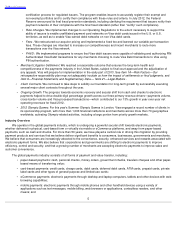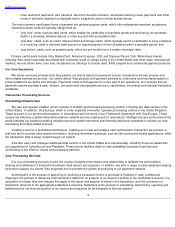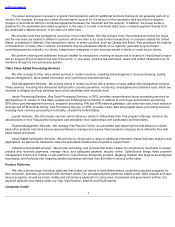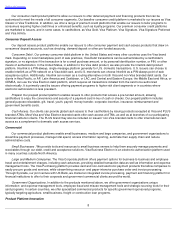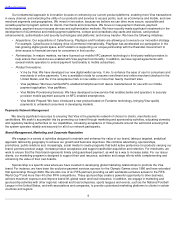Visa 2012 Annual Report Download - page 17
Download and view the complete annual report
Please find page 17 of the 2012 Visa annual report below. You can navigate through the pages in the report by either clicking on the pages listed below, or by using the keyword search tool below to find specific information within the annual report.
Table of Contents
For more information on the concentration of our operating revenues and other financial information, see Item 8—Financial
Statements and Supplementary Data — Note 14—Enterprise-wide Disclosures and Concentration of Business included elsewhere
in this report.
Working Capital Requirements
Payments settlement due from and due to issuing and acquiring clients represents a substantial daily working capital
requirement. U.S. dollar settlements are typically settled within the same day and do not result in a receivable or payable balance,
while settlement currencies other than the U.S. dollar generally remain outstanding for one to two business days, consistent with
industry practice for such transactions.
Seasonality
We generally do not experience any pronounced seasonality in our business. No individual quarter of fiscal 2012 or
fiscal 2011
accounted for more than 30% of our fiscal 2012 or fiscal 2011 operating revenues.
Employees
At September 30, 2012 , we employed approximately 8,500 persons worldwide. We consider our relationships with our
employees to be good.
Additional Information and SEC Reports
Visa Inc. was incorporated as a Delaware corporation in May 2007. In October 2007, we undertook a reorganization of the
global Visa enterprise. Prior to our reorganization, Visa operated as five corporate entities related by ownership and membership,
each of which operated as a separate geographic region. As a result of the reorganization, all except Visa Europe became
subsidiaries of Visa Inc. Visa Europe entered into a set of contractual arrangements with Visa Inc. in connection with the
reorganization. We completed our initial public offering, or IPO, in March 2008.
Our corporate Internet address is http://www.corporate.visa.com. On our investor relations page, accessible through our
corporate website and at http://investor.visa.com, we make available, free of charge our annual reports on Forms 10-K, our
quarterly reports on Forms 10-Q, our current reports on Forms 8-K and amendments to those reports as soon as reasonably
practicable after they are electronically filed with, or furnished to, the SEC. The information contained on our website, including the
information contained on our investor relations website, is not incorporated by reference into this report or any other report filed
with, or furnished to, the SEC.
ITEM 1A. Risk Factors
Regulatory Risks
Additional regulation of interchange reimbursement fees may have a material, adverse impact on our financial condition,
revenues, results of operations, prospects for future growth and overall business .
Interchange reimbursement fees represent a transfer of value among the financial institutions participating in a payments
network such as ours. In connection with transactions initiated with products in our payments system, interchange reimbursement
fees are typically paid to issuers—the financial institutions that issue Visa cards to cardholders. The fees are typically paid by
acquirers—the financial institutions that offer Visa network connectivity and payments acceptance services to merchants. We refer
to a system like ours, in which a payment network intermediates between the issuer and the acquirer, as an open-loop system.
We generally do not receive any portion of interchange reimbursement fees in a transaction. They are, however, a factor on
which we compete with other payments providers and are therefore an important determinant of the volume of transactions we
process. Consequently, changes to these fees can substantially affect our revenues and the pace or breadth of overall payment
electronification.
We have historically set default interchange reimbursement fees in the United States and many other geographies. However,
in certain jurisdictions, interchange rates and related practices are subject to continuing or increased government regulation. The
Dodd-
Frank Act has already resulted in limitations on our ability to establish default interchange rates in the debit area in the United
States. See — The Dodd-
Frank Act may continue to have a material, adverse impact on our financial condition, revenues, results of
operations, prospects for future growth and overall business . In addition, interchange rates have become subject to continued or
increased scrutiny elsewhere,
15


